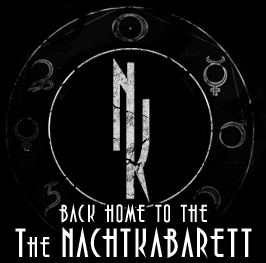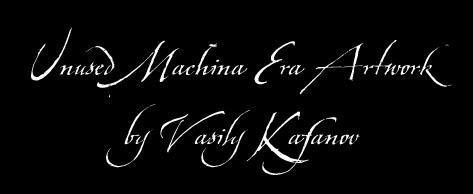
All content & writing by Brad Jaeger © The NACHTKABARETT

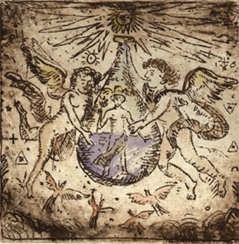 Original Source of Image: Unused Illustration
Original Source of Image: Unused IllustrationTwo angels bear up the homunculus (little man), resting in a purpled tincture as Sol radiates overhead. Underneath, numerous birds fly upwards; animal figures showing the spirit's ascension at the completion of the alchemical work. Here, purple is representative of the divinity or immortality claimed by the alchemist. The image seems in part derived from the work of Mutus Liber (The Mute Book).
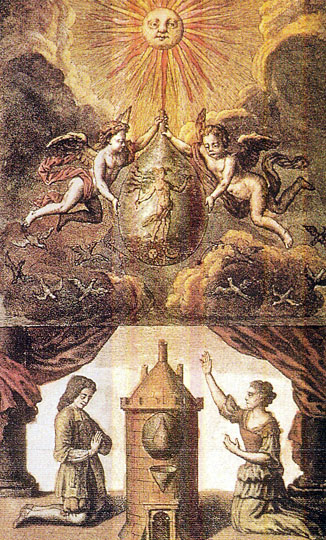 Plate 8: Mutus Liber
Plate 8: Mutus LiberIn the phial carried by the two angels, the philosophical Mercury appears. He is the product of the marriage of sun/Apollo and moon/Diana, brought together by Neptune ... The ten birds of the sublimation correspond to the serpents of the Caduceus. Two of the birds bear branches with the signs of the two fundamental saline substances of the "secret fire", tartar salt and sal ammoniac.Alexander Roob's 'Hermetic Museum'
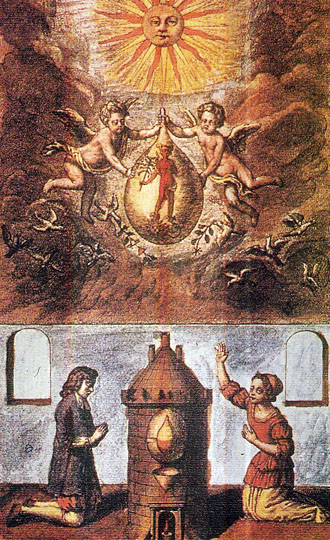 Plate 11: Mutus Liber
Plate 11: Mutus LiberThe content of the phial has now become transparent, and transformed "into the deepest depth of a bottomless light". The philosophical Mercury now appears elevated to purple redness, and the sign of the sulphurous tartar salt has been given the glyph of sublimation. At the bottom, the darkening curtains have vanished from the windows.Alexander Roob's 'Hermetic Museum'

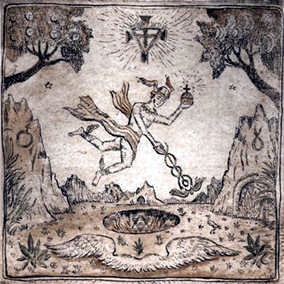 Original Source of Image: Unused Illustration
Original Source of Image: Unused IllustrationAnother depiction of Hermes -- once again he dons his winged cap and sandals. In his left hand he wields the globus cruciger; in his right hand he commands the winged caduceus. He flies overtop the Seal of Solomon/Star of David/Hexagram, imbued with the symbol of Sol. The tree branches on the left and right bear the fruit of Sol and Luna, respectively. Similarly, the fiery element of Mars is found marked on the cave underneath Sol, just as the liquid element of Mercury, represented by the fish, is found marked on the cave underneath Luna. Above Hermes, an illuminated cross within a triangle is surrounded by four trumpets. In the background are many more caves of similar nature. Finally, caduceus wings lie underneath Hermes.
Like in the previous article (Hermes atop the Philosophical Egg), Hermes once again wields the caduceus; this time however, it is winged. The caduceus also takes on a much more powerful role in this image than in the prior. It should be mentioned that the caduceus was useful not only as a psychopomp (conductor of souls), but it also could control the living and the dead, induce sleep or (and perhaps most important to the alchemists) transubstantiate matter, turning anything into gold – reflective of the spiritual journey the alchemist undergoes to transubstantiate from base, dross material, to the pure and enlightened state of perfection, represented in physical terms by gold.
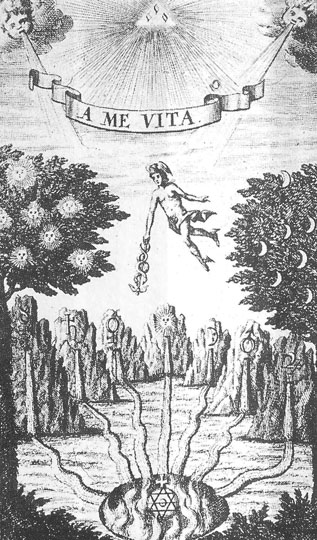 Image from Famae Alchymiae, Leipzig, 1717: a significant – and likely primary - influence on Kafanov's SP drawing. The trees bearing Sol and Luna, the flaming pit with the Star of David, the planetary caves -- all directly correlate to Famae Alchymiae. The words 'a me vita' inscribed upon the banner translate to 'way of life'.
Image from Famae Alchymiae, Leipzig, 1717: a significant – and likely primary - influence on Kafanov's SP drawing. The trees bearing Sol and Luna, the flaming pit with the Star of David, the planetary caves -- all directly correlate to Famae Alchymiae. The words 'a me vita' inscribed upon the banner translate to 'way of life'."The painted, winged Mercury is volatile by nature (…). His staff wound about with snakes points to his power (…) with which he opens heaven and earth, gives death and life and, with this powerful nature both ascends towards the sky and descends to earth, thus attaining the powers of the upper and lower things" ("Aus des Herrn de Nuysement's Tractat vom allgemeinen Geist der Welt", in: Hermetisches ABC, Berlin, 1778)Alexander Roob's 'Hermetic Museum'
In this depiction, Hermes/Mercury also bears the globus cruciger in his left hand. This, like the caduceus and the winged attire, was commonly associated with him in many depictions. One such, below:
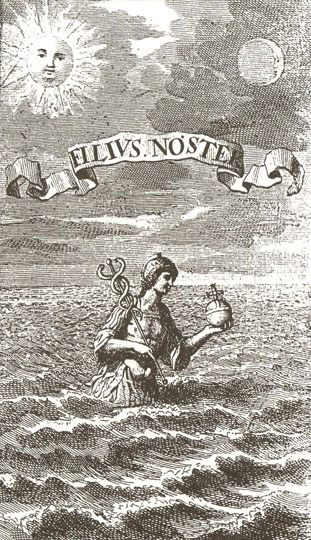 Hermes in the ocean, under the sun and moon, holding a herald's rod in his right hand and a globus cruciger in his left. From The Hermetic Museum
Hermes in the ocean, under the sun and moon, holding a herald's rod in his right hand and a globus cruciger in his left. From The Hermetic MuseumThe globus cruciger (meaning, "cross-bearing orb") is exactly that: an orb topped with a cross. Wielded by Hermes and coupled with the power of his staff, it represents his omniscient and omnipresent power.
At the bottom of the SP image lays a pair of caduceus wings, quite likely inspired by an illustration by D. Stolcius von Stolcenberg, from 1624:
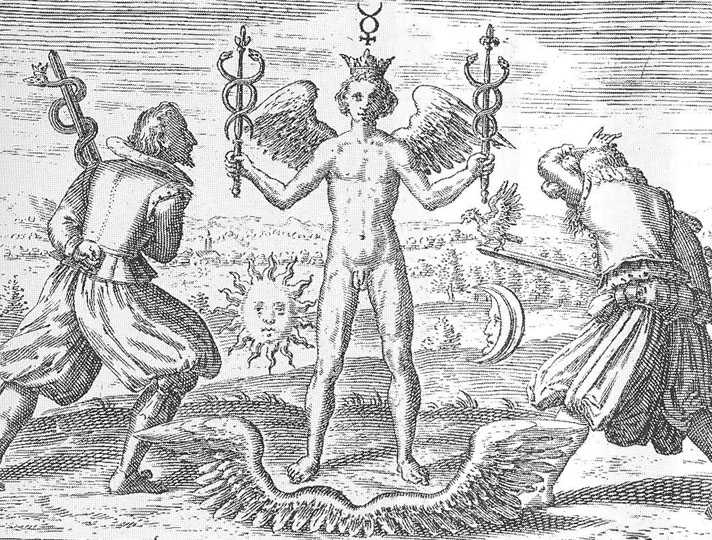 Of major significance are the wings, which likely served as inspirational basis for Vasily Kafanov's depiction
Of major significance are the wings, which likely served as inspirational basis for Vasily Kafanov's depictionThe concept of wings, particularly within alchemy, is integral to the spirit:
In the more general sense, wings symbolize spirituality, imagination, thought...In alchemy; wings are always associated with the higher, active, male principle.Dictionary of Symbols
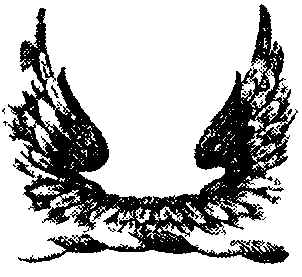 A pair of caduceus wings
A pair of caduceus wingsHermes was without question a winged god. Everything about him; from his staff (the caduceus), to his hat and sandals (petasus and talaria), were winged. Because of this, he was known as 'the swift' and 'the flying man'.
All flight and winged properties of the gods were directly connected to that of the human spirit, which had the same potential to soar and the same ability to transcend from the limitations of the earth.
Lying in a pit of fire is the Seal of Solomon/Hexagram/Star of David. When interpreted by the alchemists, this symbol was a fusion of the equilateral triangle indicative of fire, and the inverted equilateral triangle indicative of water. This union of opposites reflected the greatest alchemical maxim, "As above, so below". The hexagram also incorporated the spiritual number of seven; infinitely important to mystics and theologians throughout the ages. The six points of the hexagram all pointed to the seventh and final location - the perfect center. This is acknowledged in Kafanov's depiction, with the symbol of Sol within the six pointed star.
Above Hermes is a triangle radiating light. The triangle may represent the triune connection of mind, matter and spirit; all three of vital importance to the alchemist. The light radiating is the light of creation; of pleroma; of the source – a pure and ineffable light.
In overall context -- the planetary caves, the overhanging influence of two alchemical halves of perfection (Sol and Luna), and the union between the radiating light of above coupled with the flames below, marked by the balance of the hexagram, all serve to show the magnitude of Hermes' ability. And what is Hermes' ability? To command all that is above and all that is below.
